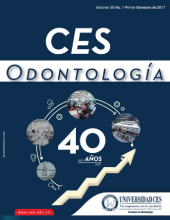Necrotizing Fasciitis of dental origin: A Case Report
DOI:
https://doi.org/10.21615/cesodon.30.1.6Keywords:
Fasciitis, necrotizing fasciitis, infection, bacteriaAbstract
Necrotizing fasciitis (NF) is an infection that affects the facial planes causingsubcutaneous tissue death, characterized by rapidly progressive,systemic toxicity and even death. The FN appears as a red, painful, withincreased temperature, swollen wound and ill-defined border. With progressionof the infection process local pain is replaced by numbness oranalgesia. Initially the skin look pale, then mottled and purple and thenfinally acquires a gangrenous appearance. FN’s ability to fast forwardthrough the fascial planes and cause tissue necrosis is due to the polymicrobialcomposition and the synergistic effects of the enzymes producedby bacteria. The treatment of this disease involves securing the airway,therapies with broad-spectrum antibiotics, intensive care, support andrapid surgical debridement repeating the process as often as necessary.The reduction in mortality from FN depends on early diagnosis and applicationof a quick and aggressive treatment.
Downloads
References
Sroczyński M, Sebastian M, Rudnicki J, Sebastian A, Agrawal AK. A complex approach to the treatment of Fournier’s gangrene Kompleksowe podejście do leczenia zgorzeli Fourniera. Adv Clin Exp Med. 2013. 22(1):131–5. https://www.ncbi.nlm.nih.gov/pubmed/23468272
Shyam DC, Rapsang AG. Fournier’s gangrene. Surgeon. 2013. 11(4):222–32. https://www.ncbi.nlm.nih.gov/pubmed/23578806
Misiakos EP, Bagias G, Papadopoulos I, Danias N, Patapis P, Machairas N, et al. Early diagnosis and surgical treatment for necrotizing fasciitis: a multicenter study. Front Surg 2017. 7(4):5 https://www.ncbi.nlm.nih.gov/pmc/articles/PMC5293831/
Loannidis O, Kitsikosta L, Tatsis D, Skandalos I, Cheva A, Gkioti A, Paraskevas GK. Fournier’s Gangrene: Lessons learned from multimodal and multidisciplinary management of perineal necrotizing fasciitis. Front Surg. 2017.4: 4-36. https://www.ncbi.nlm.nih.gov/pubmed/28740847
Elander J, Nekludov M, Larsson A, Nordlander B, Eksborg S, Hydman J. Cervical necrotizing fasciitis: descriptive, retrospective analysis of 59 cases treated at a single center. Eur Arch Otorhinolaryngol. 2016, 273: 4461-4467. http://europepmc.org/abstract/med/27287509
Ohsaki, A, Shirasaki, F, & Hirooka N. Chest Necrotizing Fasciitis with Mediastinitis. Intern Med. 2017, 56(13), 1755–1756. https://www.ncbi.nlm.nih.gov/pubmed/28674375
Huang KC, Weng HH, Yang TY, Chang TS, Huang TW, Lee MS. Distribution of fatal Vibrio vulnificus necrotizing skin and soft-tissue infections: A systematic review and meta-analysis. Medicine, 2016, 95(5). https://www.ncbi.nlm.nih.gov/pubmed/26844475
Hong G, Wu B, Lu C, Li M, Zhao G, Lu Z. Emergency treatment of 16 patients with necrotizing fasciitis caused by Vibrio vulnificus infection complicated with septic shock. Chin Med J (Engl) 2014; 127:1984-6. https://www.ncbi.nlm.nih.gov/pmc/articles/PMC4286984/
Chao WN, Tsai SJ, Tsai CF. The Laboratory Risk Indicator for Necrotizing Fasciitis score for discernment of necrotizing fasciitis originated from Vibrio vulnificus infections. J Trauma Acute Care Surg 2012; 73:1576-82. https://www.ncbi.nlm.nih.gov/pubmed/23188248
Moon-Gi Choi. Necrotizing fasciitis of the head and neck: a case report. J Korean Assoc Oral Maxillofac Surg. 2015;41(2): 90–96. https://www.ncbi.nlm.nih.gov/pmc/articles/PMC4411734/
Koh TH, Tan JH, Hong CC, Wang W, Nather A. Early clinical manifestations of vibrio necrotising fasciitis: a case series. Singapore Med J 2017, 1–12. https://www.ncbi.nlm.nih.gov/pubmed/28681055
Neeki MM, Dong F, Au C, Toy J, Khoshab N, Lee C, Borger R. Evaluating the Laboratory Risk Indicator to Differentiate Cellulitis from Necrotizing Fasciitis in the Emergency Department. West J Emerg Med. 2017 18(4), 684–689. https://www.ncbi.nlm.nih.gov/pubmed/28611889
Misiakos EP, Bagias G, Patapis P, Sotiropoulos D, Kanavidis P, Machairas A. Current concepts in the management of necrotizing fasciitis. Front Surg. 2014;1:36. https://www.ncbi.nlm.nih.gov/pmc/articles/PMC4286984/
Wilson MP, Schneir AB. A case of necrotizing fasciitis with a LRINEC score of zero: clinical suspicion should trump scoring systems. J Emerg Med. 2013; 44(5):928. https://www.ncbi.nlm.nih.gov/pubmed/23287745
Burner E, Henderson SO, Burke G, Nakashioya J, Hoffman JR. Inadequate sensitivity of laboratory risk indicator to rule out necrotizing fasciitis in the emergency department. West J Emerg Med. 2016; 17(3):333–6. http://escholarship.org/uc/item/3b75942d
Alayed KA, Tan C, Daneman N. Red flags for necrotizing fasciitis: a case control study. Int J Infect Dis. 2015; 36:15–20. https://www.ncbi.nlm.nih.gov/pubmed/25975653
Swain RA, Hatcher JC, Azadian BS, Soni N, De Souza B. A five-year review of necrotising fasciitis in a tertiary referral unit. Ann R Coll Surg Engl. 2013; 95(1):57–60. https://www.ncbi.nlm.nih.gov/pmc/articles/PMC3964641/
Downloads
Published
How to Cite
Issue
Section
License
Copyright (c) 2021 CES Odontología

This work is licensed under a Creative Commons Attribution-NonCommercial-ShareAlike 4.0 International License.
| Article metrics | |
|---|---|
| Abstract views | |
| Galley vies | |
| PDF Views | |
| HTML views | |
| Other views | |



